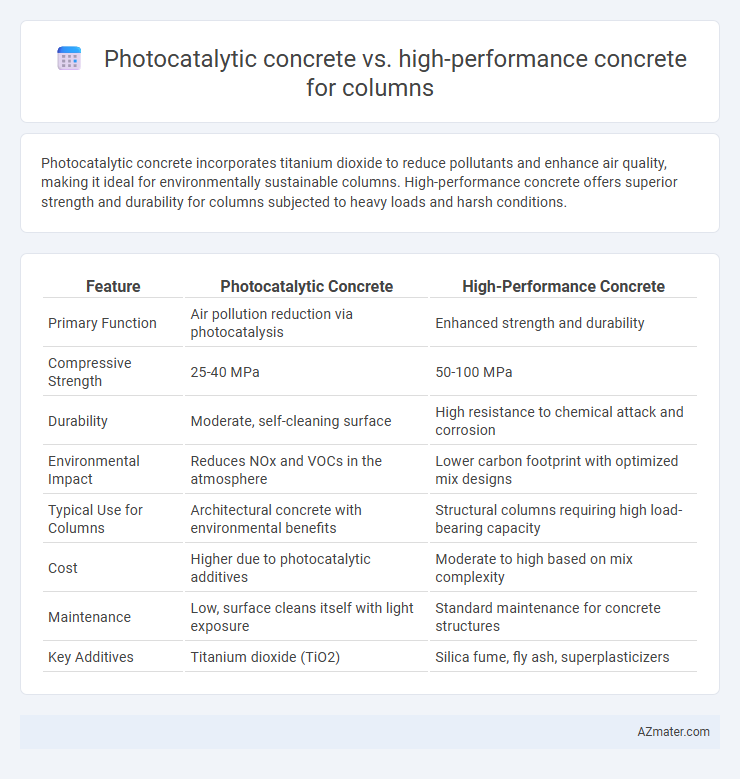Photocatalytic concrete incorporates titanium dioxide to reduce pollutants and enhance air quality, making it ideal for environmentally sustainable columns. High-performance concrete offers superior strength and durability for columns subjected to heavy loads and harsh conditions.
Table of Comparison
| Feature | Photocatalytic Concrete | High-Performance Concrete |
|---|---|---|
| Primary Function | Air pollution reduction via photocatalysis | Enhanced strength and durability |
| Compressive Strength | 25-40 MPa | 50-100 MPa |
| Durability | Moderate, self-cleaning surface | High resistance to chemical attack and corrosion |
| Environmental Impact | Reduces NOx and VOCs in the atmosphere | Lower carbon footprint with optimized mix designs |
| Typical Use for Columns | Architectural concrete with environmental benefits | Structural columns requiring high load-bearing capacity |
| Cost | Higher due to photocatalytic additives | Moderate to high based on mix complexity |
| Maintenance | Low, surface cleans itself with light exposure | Standard maintenance for concrete structures |
| Key Additives | Titanium dioxide (TiO2) | Silica fume, fly ash, superplasticizers |
Introduction to Advanced Concrete Technologies
Photocatalytic concrete incorporates titanium dioxide nanoparticles that break down pollutants and improve air quality, making it ideal for urban columns requiring environmental benefits. High-performance concrete (HPC) offers superior strength, durability, and resistance to harsh conditions, ensuring structural integrity and longevity for critical column applications. Both technologies represent advanced concrete solutions, with photocatalytic concrete emphasizing sustainability and HPC prioritizing enhanced mechanical properties.
Overview of Photocatalytic Concrete
Photocatalytic concrete incorporates titanium dioxide (TiO2) nanoparticles that activate under sunlight to break down pollutants and reduce environmental contaminants on the surface, enhancing air quality around the structure. This concrete type offers self-cleaning properties and durability, making it ideal for urban column applications exposed to pollution. In contrast, high-performance concrete prioritizes mechanical strength and durability through optimized mix design and materials but lacks inherent pollutant-degrading capabilities.
Key Features of High-Performance Concrete
High-performance concrete (HPC) for columns offers superior compressive strength ranging from 60 to 100 MPa, enhanced durability, and reduced permeability compared to standard concrete, making it ideal for structural load-bearing applications. HPC incorporates optimized mix designs with supplementary cementitious materials such as silica fume and fly ash, resulting in improved resistance to chemical attacks, freeze-thaw cycles, and abrasion. Unlike photocatalytic concrete, which primarily provides self-cleaning and air-purifying benefits through titanium dioxide additives, HPC's key features focus on mechanical performance, longevity, and structural integrity in demanding construction environments.
Photocatalytic Concrete Properties for Columns
Photocatalytic concrete incorporates titanium dioxide (TiO2) particles that activate under UV light to break down pollutants, providing self-cleaning and air-purifying properties ideal for urban column structures. Its high porosity and enhanced surface reactivity improve durability against environmental contaminants compared to conventional high-performance concrete. Photocatalytic concrete's ability to reduce nitrogen oxides (NOx) and maintain aesthetics through pollutant degradation makes it a sustainable choice for columns exposed to urban pollution.
High-Performance Concrete Benefits in Structural Columns
High-performance concrete (HPC) enhances structural columns by providing superior compressive strength, durability, and resistance to environmental stressors, which significantly extends the lifespan of buildings. Its low permeability reduces the risk of corrosion in embedded steel reinforcement, ensuring long-term stability and safety under heavy loads. HPC outperforms photocatalytic concrete in structural applications due to its optimized mix design, resulting in improved load-bearing capacity and reduced maintenance costs.
Comparative Durability: Photocatalytic vs High-Performance Concrete
Photocatalytic concrete enhances durability by actively decomposing pollutants and reducing surface grime, which mitigates degradation and prolongs the lifespan of columns in urban environments. High-performance concrete offers superior compressive strength, low permeability, and resistance to chemical attack, providing robust structural integrity under harsh conditions. While photocatalytic concrete excels in self-cleaning and environmental benefits, high-performance concrete remains superior in long-term mechanical strength and resistance to physical stress.
Environmental Impact and Sustainability Considerations
Photocatalytic concrete actively reduces air pollution by breaking down harmful nitrogen oxides through titanium dioxide additives, enhancing urban air quality and contributing to sustainable construction practices. High-performance concrete offers superior durability and strength, minimizing material usage and extending the lifespan of structural columns, which reduces resource consumption and waste generation. Both materials support sustainability, but photocatalytic concrete uniquely addresses environmental pollution, while high-performance concrete emphasizes resource efficiency and longevity in column applications.
Structural Performance and Load-Bearing Capabilities
Photocatalytic concrete incorporates titanium dioxide nanoparticles that enhance self-cleaning and pollution-reducing properties without compromising structural integrity. High-performance concrete (HPC) is engineered with optimized mix designs, including supplementary cementitious materials and chemical admixtures, delivering superior compressive strength, durability, and load-bearing capacity essential for column applications. Comparative studies show HPC typically outperforms photocatalytic concrete in maximum load resistance and long-term mechanical stability, making HPC more suitable for critical structural columns requiring enhanced performance.
Cost Implications and Lifecycle Analysis
Photocatalytic concrete incorporates titanium dioxide to reduce pollutants, increasing initial costs by approximately 15-25% compared to standard high-performance concrete used in columns. Lifecycle analysis reveals photocatalytic concrete's self-cleaning and air-purification properties can reduce maintenance expenses and extend service life by up to 20%, offering long-term economic benefits despite higher upfront investment. High-performance concrete emphasizes strength and durability, generally featuring lower initial costs but potentially higher maintenance expenses without pollutant degradation capabilities.
Choosing the Right Concrete Type for Column Applications
Photocatalytic concrete offers self-cleaning properties and air pollutant reduction, making it ideal for urban columns exposed to pollution and grime. High-performance concrete provides superior strength, durability, and resistance to environmental stress, suited for structural columns requiring long-term load-bearing capacity. Selecting the right concrete depends on whether the priority is environmental benefits and maintenance reduction or enhanced mechanical performance and structural integrity.

Infographic: Photocatalytic concrete vs High-performance concrete for Column
 azmater.com
azmater.com